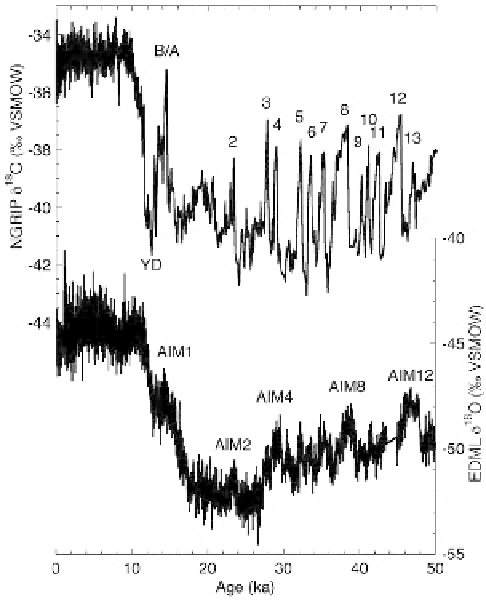Geoscience Reference
In-Depth Information
shifts of 6°C
10°C termed Dansgaard-Oeschger (D-O)
events that have a repeat time of 1
-
3 kyr [Dansgaard et al.,
1993; Severinghaus et al., 1998]. These events extended to
large areas of the North Atlantic Ocean [Bond et al., 1993;
Bard et al., 2000] and also affected the Asianmonsoon system
[Wang et al., 2001]. Correlation to Antarctic air temperature
records by methane synchronization revealed that warming
events were not in phase [Blunier et al., 1997]. This finding
led to the hypothesis that a bipolar seesaw was operating, in
which North Atlantic Deep Water (NADW) reduction was
associated with Southern Hemisphere warming [Broecker,
1998; Stocker, 1998]. Marine proxy records [Lamy et al.,
2004, 2007; Barker et al., 2009] and ocean circulation mod-
eling [Crowley, 1992; Manabe and Stouffer, 1995] support
this idea. Recently, a very detailed record of Antarctic air
temperature from the European Project for Ice Coring in
Antarctica (EPICA) Dronning Maud Land (EDML) [EPICA
Community Members et al., 2006] synchronized via methane
to North Greenland Ice Core Project [Rasmussen et al., 2006]
reveals a complex relationship between Antarctic and Green-
land air temperature (Figure 1). Signi
-
cantly, each Greenland
interstadial appears to have a corresponding warming event in
the EDML core, which is termed an Antarctic isotope maxima
(AIM). AIM events seem to precede onset of Greenland
warming but peak at about the same time, and their magnitude
correlates with the duration of Greenland interstadials at least
during marine isotope stage 3 (MIS 3) [EPICA Community
Members et al., 2006].
The D-O events are episodically punctuated by ice-rafting
events known from North Atlantic sediments, termed Hein-
rich events [Heinrich, 1988; Hemming, 2004]. The youngest
event occurs during the Younger Dryas [Andrews et al.,
1995], an enigmatic cold snap that occurred during the last
deglaciation [Broecker and Denton, 1989; Alley, 2000]. The
leading hypothesis for the cause of the Younger Dryas is a
rerouting of Laurentide Ice Sheet (LIS) meltwater away from
the Gulf of Mexico to the North Atlantic via a route that is a
topic of current debate. Broecker et al. [1989] suggested that
ice sheet recession in North America allowed eastward rout-
ing through the St. Lawrence Seaway, which found some
support in reconstructions of LIS meltwater routing [Teller,
1990; Licciardi et al., 1999] and ocean modeling [Manabe
and Stouffer, 1997]. However, marine evidence for meltwa-
ter input via this route is equivocal [e.g., Rodrigues and
Vi lks, 1994; Keigwin and Jones, 1995; deVernal et al.,
1996; Carlson et al., 2007; Peltier et al., 2007]. Furthermore,
a field campaign in eastern Canada to search for geomorphic
and geologic evidence for meltwater
Figure 1.
Comparison of polar ice core records for the 0
-
50 ka
interval including North Greenland Ice Core Project (NGRIP)
δ
18
O[EPICA Commu-
nity Members et al., 2006]. Younger Dryas (YD), Bølling/Allerød
(B/A), and numbered Dansgaard-Oeschger (D-O) events are la-
beled on the NGRIP
δ
18
O[Rasmussen et al., 2006] and EDML
δ
18
O record, and Antarctic isotope maxima
(AIM) events are labeled on the EDML
δ
18
O record.
[Broecker, 2006a]. More recently, Murton et al. [2010] pre-
sented evidence for northward meltwater
flow into the Arctic
Ocean, which supports earlier modeling studies [Tarasov and
Peltier, 2006]. Rashid et al. [this volume] present evidence
from the Labrador Sea for ice rafting and potential meltwater
from under the LIS and out through Hudson Strait. In what-
ever fashion LIS meltwater entered the Atlantic Ocean, geo-
chemical records clearly indicate a reduction of Atlantic
meridional overturning circulation (AMOC) during the
Younger Dryas, although the magnitude may have been less
severe than during Heinrich stadial 1 [Hughen et al., 1998,
2000; Keigwin, 2004; McManus et al., 2004; Keigwin and
Boyle, 2008].
Proxy records from high accumulation rate sediment cores
in the Gulf of Mexico can help test the routing hypothesis
as the cause of the Younger Dryas and the D-O cooling
events. Here we present published and new Mg/Ca and
stable isotope measurements on the planktic foraminifer
Globigerinoides ruber from four northern Gulf of Mexico
flow during the Younger
Dryas determined that meltwater conduits were formed
after the Younger Dryas [Lowell et al., 2005; Teller et al.,
2005], highlighting the uncertainty of meltwater rerouting










Search WWH ::

Custom Search